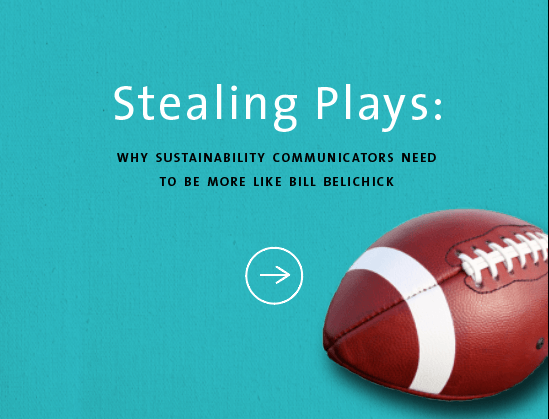
By Geoff Ledford
Sustainability can be incredibly engaging. The pressing issues of our day demand that humans find new ways of existing – and quickly. Happily, society’s attitudes about sustainability are heading in a positive direction. In recent years, consumers have begun to demonstrate a preference for sustainable products and services, while many businesses have embraced sustainability and corporate social responsibility (CSR) as part of the way they operate. As sustainability practitioners and communicators, the world is primed to listen to our message.
So, why is it that the vast majority of sustainability messaging isn’t as nearly memorable or effective as an average beer commercial?
Although a full answer to that question is large and complicated (and far out of the scope of this blog post), some insight can be gained in understanding how marketing folks (the ones who come up with those clever beer commercials) go about their craft. Oftentimes, you’ll remember an ad or a jingle for a product you’d never seriously consider purchasing – meaning that the messages are often of a higher quality than the products or services being promoted. Marketing people are incredibly adept at engaging audiences – and we should take time to study what makes them so effective.
In honor of the return of Bill Belichick and the forthcoming NFL season, what follows are four plays that have been “stolen” (a la Spygate) from the marketing playbook. These techniques serve as a reminder that we can amplify our sustainability messages if we’re willing to borrow from others.
1. Be concrete
Human brains are programmed to like concrete thoughts and ideas. “Zero emissions” is an abstraction. The Tesla Model S is concrete – and a whole lot more memorable. When explaining abstract material issues or priority focus areas, use as many concrete words, examples, and stories as possible to make your message resonate. (Then back up your claims with concrete data.)
2. One overarching message at a time
Ever notice that companies generally only run one big marketing push at a time? (For example, “Live Mas” would never have cohabitated with “Yo Quiero Taco Bell.”) Meanwhile, material issues tend to come in clusters of ten or twenty.
Trying to address more than one or two “focus areas” won’t work if these focus areas aren’t connected into a larger narrative or strategic framework. If you want your CSR messaging to resonate, pick an overarching message, cause, or theme that you want to communicate – and let material issues reinforce that message. They won’t work nearly as well if they’re forced to stand alone.
3. Put your brand in the driver’s seat
Messages coming from CSR or sustainability departments often look, sound, and feel entirely different than those coming from the rest of a company. This can leave stakeholders feeling like a company has a bit of schizophrenia.
Infusing brand voice into CSR communications does not mean that sustainability messaging needs to be watered down or turned into marketing fluff. Rather, if CSR messaging reinforces the brand – in look, feel, and tone of voice – it can make those communications engaging, consistent, and unmistakably recognizable.
4. Leverage the power of emotion
Advertising and marketing communicators use a finely-tuned balance of emotional and rational appeal to ensure that messages engage their audiences. Meanwhile, hardcore sustainability communications (such as sustainability reports or corporate CSR messaging) tends to be more heady. As a result, they miss an opportunity to appeal to what (at our core) makes us most human.
While pulling on heartstrings without substantive action to back up claims is never a good idea (and can lead to a painful fall from grace for brands that employ this tactic), the manipulative ploys of a few bad actors do not mean that all emotional appeal is categorically bad. Things like vision, mission, and purpose – the things that have the power to motivate truly disruptive change – all work precisely because they appeal to humans on an emotional level. And emotional appeal can be a powerful catalyst for change.
Before you can convince anyone of anything – be it buying an electric vehicle, reducing water consumption during production of goods, or simply remembering to put down the toilet seat – you have to first give your audience a reason to care. Sustainability practitioners should take note of the tactics and techniques of our marketing and advertising counterparts, and, ahem, “borrow” (thanks, Bill) them whenever possible. Because, our messages often focus on telling audiences what we are doing, when they should be focused on giving them a reason to care and believe.
Geoff Ledford is a Creative Strategist at thinkPARALLAX – a strategic creative communications agency with a passion for building brands with purpose. We work at the intersection of business strategy, sustainability, and communication. Our values stem from the belief that profit and sustainability are not mutually exclusive – good business means doing the right thing. We cultivate knowledge, spread awareness, and create purposeful connections with audiences.
Image courtesy of thinkPARALLAX
TriplePundit has published articles from over 1000 contributors. If you'd like to be a guest author, please get in touch!














